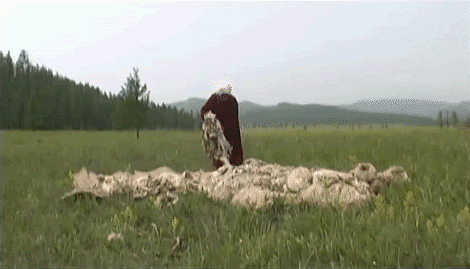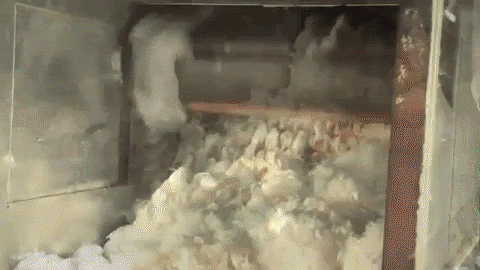SOME PROPOSITIONS
IN FELT
MATERIAL STUDIES --- SUMMER 2019 --- WRNS STUDIO
Research and speculation on the merits of felt as an architectural material. A part of the WRNS intern material research endeavor.
International Wool Textile Organization ; Janice Arnold | Museum of Craft and Design
FELT 101:
Felt is a textile usually made from sheep wool or other animal hairs. It is the oldest known textile to human history, dating back as early as 9000 BCE. Unlike other textiles, felt is not woven, but rather made by compressing fibers.
Pre-industrial revolution, felt was made by laying wool out onto a canvas, combing and beating it down, wetting the fibers, and rolling it up in a canvas. The roll of moist wool would then be compressed by either stepping on it repeatedly or by attaching it to a galloping equine.
Today, felt is made through the same elemental processes, just mechanized. Wool is sorted into batts, combed into sheets that are layered and steamed, then compressed to form the textile.


Mongolian Felt Making | Ragcha Media ; National Industrial Co.
A+ QUALITIES OF WOOL FELT:
Manages moisture: Wool fiber has a hydrophobic exterior and a hydrophilic interior. This quality allows the follicles within the fiber to hold up to a third of its weight in moisture and still feel dry to the touch.
Suppresses mold and mildew: Wool is a keratin and therefore suppresses the growth of mold and mildew.
Absorbs sound: Both felt and wool absorb sound. The noise reduction coefficient of felt can range from .9 to 1.15.
Insulates thermally: Felt is an effective thermal insulator. The R value of wool batts ranges from 3.6 to 4.3 per inch of thickness, but generally tends to perform better than its rated R value because of it's ability to manage moisture.
Resists Fire: Due to its high nitrogen content, wool will not support a flame below 1100F, meaning dangerous flame retardants are not necessary while still conforming to Class A of building code.
Doesn’t off-gas: Unlike synthetic materials, wool felt is devoid of glues, bonding agents, and other harmful chemicals.
Improves indoor air quality: The amino acids in wool irreversibly bond with formaldehyde and other toxins, making felt a material that actually improves air quality.
Renewable and sustainable resource: Wool felt has the potential to be very sustainable. As an animal product, it is a renewable resource, and when wool production is paired with meat or milk production, sheep farming can produce more resources at once, wasting less. Felt itself does not have intensive manufacturing processes and can be recycled or composted, avoiding landfills.
Facts from Carbon Smart Materials Palette
As one can deduce from the above list, the performative qualities of felt are really quite remarkable. Yet, despite all of these sensible qualities, we really don’t see much felt in the world's architectural material repertoire, and when we do it’s mostly for finishes or furniture. Though experimentations with various digital fabrications of felt, like 3D knitting, robotic needle felting, and felt/resin composites are being explored in architectural institutions and material science labs, again, these high-tech felts are still largely used as finish materials and furnishings.
So, as an architect, I’m asking, how we can use felt architecturally? — as a part of a wall or a floor system or even as a wall itself?
Through a series of case studies and my own speculations, the following provocations present how felt, wool, and even sheep can or could be used architecturally in four ways: as a membrane, sheathing, insulation, and partition.
1) FELT AS MEMBRANE
Despite it's near absence in contemporary building practice, felt has actually been used architecturally for yurt cladding since 600 BCE. A yurt, for those unfamiliar, is a traditional dwelling originating in Mongolian grasslands by nomadic herding communities. At its most basic, a yurt is just a tensile fabric structure.
Though the practice of yurt building has diminished with modern building technology, there's been a slight resurgence of this typology as a part of the tiny house movement and more generally with an increase in sustainable living trends.
Matthieu Paley | National Geographic ; James L. Stanfield | National Geographic
Sometime in between 600 BCE and the tiny house movement, Buckminster Fuller devised his iconic geodesic domes. Similar to a yurt, the geodesic dome is also a structure made of a tensile skeleton, but instead of cladding with felt, Fuller instead usually covered his domes with plastic. Though several domes were built, they never caught on as a prolific typology, and performatively failed as a habitable shelter due to high solar heat gains even causing some, like the biosphere in Montreal, to catch fire.
Buckminster Fuller | Geodesic Domes
Proposition 1: Felt as Membrane asks: Instead of plastic, what if Bucky had used some A+ wool felt on those domes? Would there have been less solar heat gain? Yes. Fewer fires? Almost definitely. Would we all be living in a geodesic dome just like he had dreamed of? Maybe.
Today, to use felt as an architectural membrane harkens back to the old, old, traditional sensibilities of the ancient world, while simultaneously capitalizing on new technologies that could lead to many exciting possibilities.
2) FELT AS SHEATHING
3) FELT AS INSULATION
Though not as prevalent as its more toxic counterparts, felt is already being used as insulation in buildings and mobile homes. For the most part, however, this wool is just being used as a 1:1 replacement for conventional insulation.
But, can insulation do more? Can it be multi-functional? Utilitarian, but also productive?
When plants are used as a building material in green walls and vertical gardens, they are simultaneously both productive and architecturally functional. Within the same logic, Prop. 3: "Felt" as Insulation expands the idea of vertical farming to include animal husbandry. In lieu of the more typical batt or rigid insulation, the cavity of the wall is simply deepened and live sheep are inserted to break that thermal bridge.
If the sheep wall too brazen for you, Prop. 3: "Felt" as Insulation explores an alternative, still using a living, growing, organic material as insulation, but sans animal. It imagines a near future where we plant a wool "seed" inside a wall and grow our insulation — not dissimilar to mycelium.
4) FELT AS PARTITION
Joseph Beuys, a prominent artist of the of the mid to late 1900's, did a lot of his work with felt. He saw felt as a symbol for warmth, life, coziness — a return to a past through a material that contrasts the increasing coldness of modern-day life. He used felt, I would argue, architecturally, to change the atmosphere of a room. In these spaces everything is muffled and quiet, acoustically different from what we are accustomed to, and when many people gather, you can literally feel the room getting warmer.
Joseph Beuys | Plight ; Joseph Beuys | Brasilienfond
Le Corbusier | Villa Savoye
The idea of the interior partition, or a non-load bearing wall, originates with Le Corbusier’s free plan. The free plan assumes that structural columns could liberate the building from structural walls, and thus the partitions would be free to take whatever shape one desires. But, in reality, architecture never really took full advantage of this freedom. Interior partitions are still made with sheet goods and dimensional studs that are straight and standardized, thus, on lives the straight wall and 90 degree angle. Felt, unlike other sheet goods, can be infinitely long, can bend and fold and stack, and thus create walls in any shape. Formally, the possibilities are endless. Atmospherically, learning from Joseph Beuys, maybe we would be living in warmer, rounder, quieter, softer architecture.